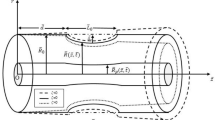Summary
Based on a microcontinuum model, an initial value investigation is made of the pulsatile blood flow through a rigid circular tube with entrance effects due to the impulsive action of an arbitrary as well as particular pressure gradient. The solutions for the unsteady velocity field as well as the microrotation velocity of the blood red cells are explicitly determined. The asymptotic behavior of the solutions is studied with physical significance. Special attention is given to the investigation of the entrance effects on the structure of the blood flow. It is shown that the entrance effects are reflected in the solutions of the problem through the terms containing the exponential factor exp (−zbδ/V), and the solutions are significantly different from those of the fully developed flow. It is also predicted that the present theory gives rise to a boundary layer phenomenon not present in the previous works in the microcirculation of blood. This new boundary layer is introduced by the influence of the entrance effects. This analysis reveals the generation and propagation of waves in the blood vessels travelling downstream with velocityV/b. These waves are primarily caused by the entrance effects and eventually decay within the boundary layer distance of the orderV/(bδ). An exact as well as an approximate equation for the oscillatory inlet length is derived. Several limiting cases of physical interest are also discussed.
Zusammenfassung
Ausgehend von einem Kontinuumsmodell mit Mikrostruktur, wird eine Untersuchung der pulsierenden Strömung von Blut durch ein starres Kreisrohr zufolge der Impulswirkung von beliebigen und auch speziellen Druckgradienten durchgeführt. Die Lösungen des instationären Geschwindigkeitsfeldes und des Feldes der Mikrorotationsgeschwindigkeit der roten Blutkörperchen werden bestimmt. Das asymptotische Verhalten und die physikalische Bedeutung werden untersucht. Insbesondere untersucht wird der Einfluß des Eintrittseffektes auf die Struktur der Blutströmung. Es wird gezeigt, daß diese Eintrittseffekte durch Glieder mit dem Faktor exp (−zbδ/V) in der Lösung wiedergegeben werden, und daß die Lösungen sich deutlich von denen der Strömung ohne Eintrittseffekt unterscheiden. Diese Theorie führt zu einer durch den Eintrittseffekt hervorgerufenen Grenzschichterscheinung, die in vorangegangenen Arbeiten über die Mikrozirkulation von Blut nicht auftrat. Ferner zeigt sie die Entstehung und Ausbreitung von Wellen von Blutkörperchen, die mit der GeschwindigkeitV/b sich stromabwärts ausbreiten, durch den Eintrittseffekt bedingt sind und mit der OrdnungV/(bδ) abklingen. Eine exakte und eine Näherungsgleichung für die Einströmlänge wird hergeleitet. Verschiedene Grenzfälle von physikalischem Interesse werden diskutiert.
Similar content being viewed by others
References
Eringen, A. C.: Theory of Micropolar Fluids. J. Math. and Mech.16, 1–18 (1966).
Bugliarello, G.: Microcircular Hemodynamics and Other Biological Flow Problems. Biomedical Fluid Mechanics Symposium-ASME1966, 192–208.
Ariman, T.: On the Analysis of Blood Flow. J. Biomech.4, 185–192 (1971).
Ariman, T., M. A. Turk, andN. D. Sylvester: On Steady and Pulsatile Flow of Blood. Journal of Appl. Mech.41, 1–7 (1974).
Turk, M. A., N. D. Sylvester, andT. Ariman: On Pulsatile Blood Flow. Trans. Soc. Rheology17, 1–21 (1973).
Ariman, T., M. A. Turk, andN. D. Sylvester: On Time-Dependent Blood Flow. Letters in Applied and Engineering Sciences2, 21–36 (1974).
Targ, C.: Basic Problems of the Theory of Laminar Flow. State Publication House for Tech. and Theoretical Literature. Moscow 1951.
Sneddon, I. N.: The Use of Integral Transforms. Mc Graw-Hill. 1972.
Doetsch, G.: Guide to the Applications of the Laplace andZ Transforms. Van Nostrand Reinhold Company. 1971.
Bugliarello, G., andJ. Sevilla: Velocity Distribution and Other Characteristics of Steady and Pulsatile Blood Flow in Fine Glass Tubes. Biorheology7, 85–95 (1970).
McDonald, D. A.: Blood Flow in Arteries. London: The Williams & Wilkins Company. 1974.
Fung, Y. C., N. Perrone, andM. Anliker, (ed.): Biomechanics. Prentice-Hall, Inc. 1972.
Author information
Authors and Affiliations
Rights and permissions
About this article
Cite this article
Debnath, L. On a microcontinuum model of pulsatile blood flow. Acta Mechanica 24, 165–177 (1976). https://doi.org/10.1007/BF01190368
Received:
Issue Date:
DOI: https://doi.org/10.1007/BF01190368




